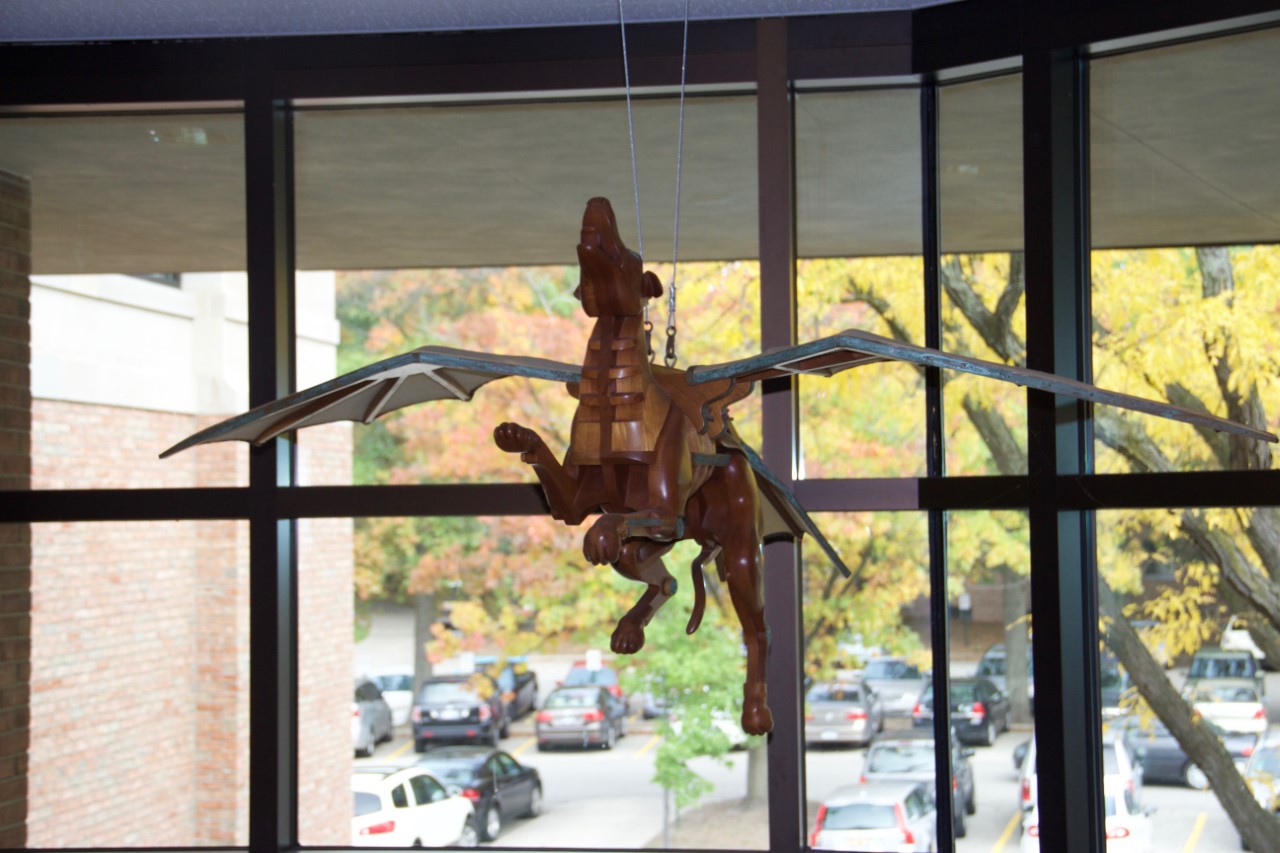On Friday Oct. 7, James Mellick, a former Calvin art professor, was announced the winner of the ArtPrize 2016 Public Vote award for his entry “Wounded Warrior Dogs.” The Public Vote award is tied with the Juried Grand Prize as the most lucrative prize in the competition; Mellick took home a prize of $200,000 for his six wood-carved dogs each depicting a soldier’s injury surround a dog’s casket draped in an American flag in Mellick’s piece.
A feeling of disbelief came over Mellick when he accepted his award.
“I see it as a win for all the voters too,” said Mellick in an interview with Chimes. Viewers this year recognized that good art is form and concept coming together. Viewers were voting for their “values” and “it’s like their values were being confirmed,” said Mellick.
Mellick’s piece was partly motivated by a lack of awareness about the problems facing veterans. More and more veterans are coming home with casualties but are not receiving the treatment they need, and unless people have a personal connection to a veteran, they tend to ignore them, noted Mellick.
“The artwork brings it to front and reminds people that veterans have lost their limbs and even their lives fighting for us,” said Mellick.
Mellick invited Calvin students to help out during ArtPrize. Hyereen Shin, an art major, handed out voting cards and talked with viewers at the exhibition.
Tears streamed down viewers’ faces as they thanked Mellick for making such a touching piece. Mellick did well to choose a theme that connects with people so deeply, said Shin.
Originally only 1,500 voting cards were printed for Mellick’s exhibit. By the end of Art Prize, over 22,000 voting cards had been handed out.
Calvin art professors Frank Speyers and Anna Greidanus, who taught alongside Mellick during his years on Calvin’s faculty, expressed their pride for their former colleague.
“I was absolutely delighted that Mellick won. He is a hardworking artist who has worked on using dogs as social metaphors for a long time,” said Greidanus.
Mellick is a “passionate artist” who actively “visualizes issues and makes them come alive in material,” said Speyers. The reason Mellick’s art is “phenomenal” is because of the “high aesthetic quality,” said Speyers.
Mellick taught sculpture, drawing and art appreciation courses at Calvin from 1989 to 1991. He focused on teaching students technique and how to develop ideas from a drawing. He challenged his students to understand material, the role of craftsmanship and how to artfully craft in various art forms.
Mellick loved to talk about different issues and artistic insights. Greidanus and Mellick said they had “great conversations” about the traditions of wood sculptures and ceramic cultural forms.
“We sort of appreciated each other’s ability to work with a particular material with a great deal of skill,” said Greidanus.
While teaching, Mellick actively created art in his downtown studio. Calvin bought two of his art pieces while he was a faculty member.
“Da Vinci’s Dog” (1987) was a response to the disaster involving the space shuttle the Challenger.
This is a “challenging piece”, said Joel Zwart, Director of Exhibitions at Calvin. It originally hung in the science building. However, many people in the sciences “were not interested in putting it there,” said Zwart. Believing that it alludes to scientific experimentation on animals, many “voiced their opinions against hanging it there,” said Zwart.
The piece hung in the CFAC lobby until 2010 when it was taken down for renovations. Once completed, “Da Vinci’s Dog” moved to the stairwell, so it could be easily accessible and noticeable.
Mellick’s piece “Northwest Indian Macaw” (1991) is located in the top of the CFAC. Written around the collar of the Macaw is the message “May the Spirit of Jesus be with Calvin College.”
Mellick was thankful that his work has continued to be featured, even after he no longer teaches at the college. “It means a lot to me that the work is appreciated and not stuck back in some box somewhere,” said Mellick.
The Calvin art collection is committed to representing art by students and faculty. The collection encourages the Calvin community to “embrace and understand the power of art forms,” according to Greidanus.
The fact that Mellick’s pieces are still on display demonstrates that Calvin has an art program that “distributes really amazing pieces of art,” said Greidanus.
Since 1985, Mellick has been creating dog allegories. He plans to add an 8th dog representing depression to the Wounded Warrior Dogs piece. Mellick hopes to display his exhibit in a national gallery in the future.
When Speyer first saw Mellick’s work, he recalls saying, “Wow, this could end up in the Smithsonian.”
The winning work, “Wounded Warrior Dogs,” will be on display next at the Ohio Craft Museum in Columbus during Feb. and Mar. 2017.









